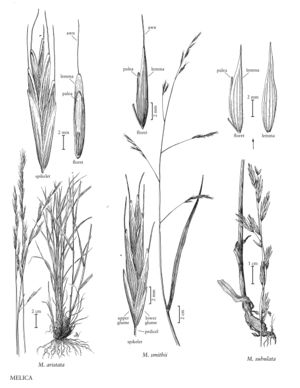Difference between revisions of "Melica smithii"
FNA>Volume Importer |
FNA>Volume Importer |
(No difference)
| |
Revision as of 21:17, 16 December 2019
Plants loosely cespitose, not rhizomatous. Culms 60-160 cm, thickened basally, sometimes appearing cormous; internodes sometimes pubescent below the nodes. Sheaths usually glabrous, sometimes pilose or retrorsely scabrous, particularly at the throat, veins often prominent; ligules 2-4 mm; blades 15-25 cm long, 5-12 mm wide, both surfaces usually scabridulous, glabrous, sometimes the adaxial surfaces with hairs. Panicles 12-30 cm; branches 7-11 cm, spreading to reflexed, with 4-7 spikelets, spikelets restricted to the distal portion, axils frequently with brownish pulvini; pedicels straight; disarticulation above the glumes. Spikelets 12-18 mm, with 3-5 bisexual florets; rachilla internodes 2.5-3 mm. Lower glumes 4.5-7 mm long, 1-1.5 mm wide, 1-3-veined; upper glumes 6.5-9 mm long, 1.2-1.8 mm wide, 3-5-veined; lemmas 9.5-12 mm, glabrous or scabrous, 7-veined, apices bifid to emarginate, awned, awns 3-10 mm; paleas about 2/3 the length of the lemmas; anthers 1.3-2.5 mm; rudiments 3.5-6 mm, tapering, resembling the bisexual florets. 2n = unknown.
Distribution
Wash., Mont., Mich., Wis., Oreg., Alta., B.C., Ont., Que., Idaho, Wyo., S.Dak.
Discussion
Melica smithii grows in cool, moist woods from British Columbia and Alberta south to Oregon and Wyoming and, as a disjunct, from the Great Lakes region to western Quebec. It often forms colonies in the eastern portion of its range. Its disjunct distribution pattern is unusual among North America's grasses.
Selected References
None.
